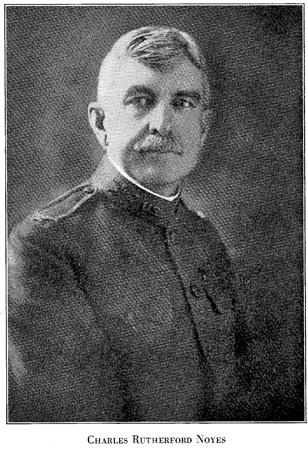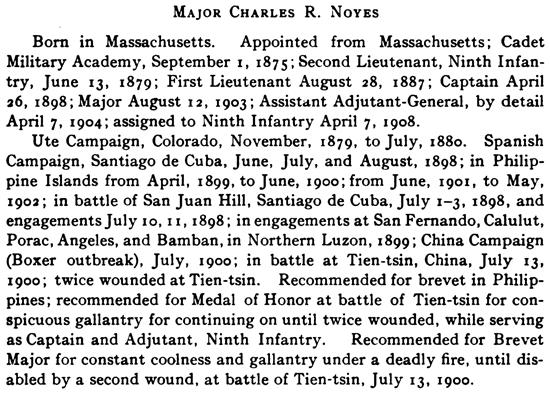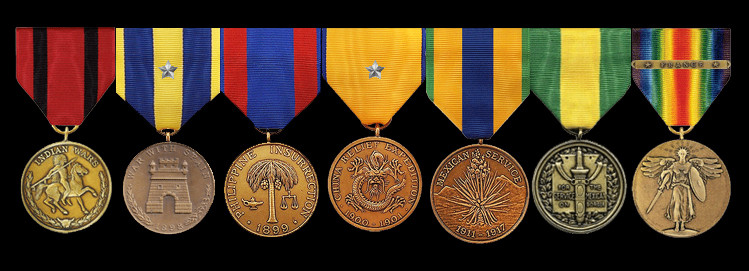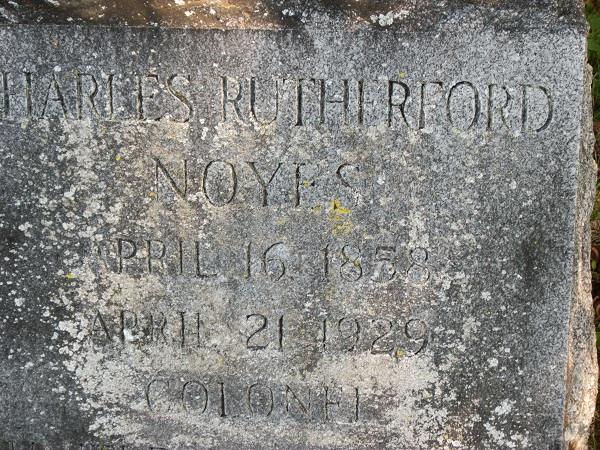 ¹
¹
 ¹
¹
Charles R. Noyes
Commander 22nd Infantry
April 25, 1914 - July 7, 1914
Charles Rutherford Noyes was
born in Massachusetts on April 16, 1858. He entered the US
Military Academy on
September 1, 1875 and graduated 28 out of a class of 67 on June
13, 1879. His best subjects at the Academy were
Drawing and Spanish and his worst subjects were Law and
Ordnance/Gunnery. He was a Sergeant in the
Battalion organization of the Corps of Cadets. Upon graduation he
was commissioned a 2nd Lieutenant in the 9th Infantry.
He was assigned to Company F and
served on frontier duty at Fort McKinney, Washington Territory
(Wyoming)
from October 4-6, 1879, then at Rawlings, Wyoming until November
5, 1879. From that date Noyes was at the Camp
on the Snake River until July 1, 1880. From July 1 to November 8,
1880 his duty station was Cheyenne Depot, Wyoming.
In September 1880 Noyes
joined President Rutherford B. Hayes on Hayes' train trip
through Wyoming. The following passage illustrates that event:
In September
1880, President Hayes began an extended tour through the western
United States. It was the first time
a sitting president had ever traveled to the West Coast. The
journal of Lt. Charles R. Noyes, albeit brief, is one of the few
firsthand accounts of Hayes' Western Trip.
As the President and First Lady's special train steamed westward
across the plains, Lt. Noyes discovered his post was one
of the scheduled stops. Lt. Noyes, then only twenty-one years of
age, introduced himself to the President. Hayes and
General William T. Sherman invited Noyes to join the entourage
for the four-day trip by rail through Wyoming to Salt Lake City,
Utah.
Lt. Charles Rutherford Noyes was the son of Horatio S. Noyes, a
first cousin of President Rutherford B. Hayes.
Noyes was born in Newtonville, Massachusetts, in 1858 and
graduated from the United States Military Academy in 1879.
Following graduation, he was stationed in the West. He later
returned to West Point to teach mathematics. In 1898,
Noyes married cousin Gertrude Noyes. Major Noyes was severely
wounded during the Boxer Rebellion.
From the Rutherford B. Hayes Presidential Center
Noyes was stationed at Fort
Sidney, Nebraska from November 8, 1880 until September 16, 1882.
Next he was
at Fort Douglas, Utah until October 25, 1882. He was at Fort D.A.
Russell, Wyoming and on detached service
from October 25, 1882 to July 20, 1886.
In July 1886 the 9th Infantry
moved to Arizona and Noyes was stationed at Whipple Barracks,
Arizona from July to
December 10, 1886, then at Fort Verde, Arizona to February 10,
1887 and then back to Whipple Barracks. From
August 4, 1887 to August 9, 1888 he was part of the force at the
San Carlos Reservation. During that duty he was
promoted to 1st Lieutenant on August 28, 1887. In 1888 he was
officially assigned to Company G.
On August 28, 1888 Noyes was detailed to the US Military Academy at West Point as Assistant Professor of
Mathematics where he remained until June 14, 1892. He returned to his regiment and was made Regimental Adjutant,
a postion which he occupied from June 18, 1892 to June 17, 1896 at Madison Barracks, Sackett's Harbor, New York.
He was then assigned to Company C. From March 28 to May 26, 1898 he was on detached sevice at Iowa Wesleyan
University at Mount Pleasant, Iowa, when his Regiment received orders to move to Tampa in anticipation of deployment
to Cuba. While at the University Noyes received a promotion to Captain. He joined his Regiment at Tampa on May 29
and took command of Company C. On June 25 the 9th Infantry landed in Cuba at Siboney.The 9th Infantry took part in the attack on San Juan Hill on July 1, though not in the first assault wave. Noyes lost
no members of his Company killed in action but Company C had seven Soldiers wounded during the campaign
and four died of disease. The Regiment returned to the U.S., went into quarantine at Camp Wikoff on
August 15, 1898 and stayed there until September 11 when it returned to its previous duty station at Madison Barracks.
²
In the photo above Charles Noyes is second from the left. His rank is given as Lieutenant but by this time he was a Captain.
The 9th Infantry Regimental battle flag is on the right.
After rest and recruitment to fill in the Regiment the 9th Infantry moved by train to California in March 1899 to prepare
for deployment to the Philippines. Noyes and Company C sailed on the steamship Zealandia on March 28, arriving in
the Philippines on April 26. Within three days Company C was engaged in battle at Pateros where it lost one man killed
in action. On May 19 Noyes was appointed Regimental Adjutant and he left Pateros for Manila, where he assumed his
Adjutant duties. On July 18 Noyes was back in the field, having taken command of 2nd Battalion, consisting of Companies
B, C, E and I. On August 19 he resumed his Adjutant duties. He was still the Adjutant when the Regiment sailed to China
and he landed there with the Regimental staff on July 6, 1900.On July 13, 1900 while the Regiment was forming up as part of the force set to attack the city of Tientsin Noyes was
slightly wounded in the arm by rifle fire from the city. In the assault on the city's walled fortifications Noyes was wounded
a second time, severely enough to have to be removed from the front line. He remained in Tientsin until July 29 when he
sailed on the U.S.A.T. Solace to Nagasaki and then to the United States for convalescent leave. He returned to China on
December 2, 1900 and reported to the Regiment on December 18 when he resumed his Adjutant duties. He was the
Adjutant of the 9th Infantry at Camp Reilly, Peking from December 19, 1900 to the dismantling of the Camp on May 19, 1901.
On May 25, 1901 Noyes left China with the Regiment, arriving in Manila on June 2 aboard the transport Indiana.He was the Adjutant for the Regiment at Calbayog, Island of Samar until April 1902 when the 9th Infantry returned to the U.S.
and he was then stationed at Madison Barracks, New York.
²
Officers of the 9th Infantry at Madison Barracks, New York, 1902.
Captain Charles R. Noyes is in the center, back row, standing in the middle of the doorway,
looking directly at the camera. Note the mixture of model 1895 and model 1902 caps.
At least four non-commissioned officers are included in this portrait.
On August 12, 1903 Noyes was promoted to Major.
He was detailed to the Adjutant General's Department and became the Acting Assistant Adjutant-General
at Headquarters, Department of the Missouri at Omaha, Nebraska on September 18, 1903. On April 7, 1904
he was made (by detail) Adjutant-General of the Department of the Missouri. He remained in this position
at Omaha until April 7, 1908 when he was relieved of the detail and assigned back to the 9th Infantry.
Photo of Officers of the U.S. Army
Department of the Missouri,
Omaha, Nebraska early 1904.Charles R. Noyes is in the middle row,
far right.The original caption to the photo listed him
as Major, Chief of Staff and Adjutant General
of the Department.Photo from Omaha Daily Bee March 06, 1904
From the Nebraska Newspapers website
Noyes was at Fort Sam Houston, Texas from June 1908 to March 1910. In May 1910 he was
back in the Philippines, at Camp Downs on Leyte.On March 3, 1911 Noyes was promoted to Lieutenant Colonel of the 21st Infantry.
From May 1911 to February 1912 he was at Ludlow Barracks, Mindanao.
He was assigned to the General Staff Corps from May 1912 to March 1913. From May 1912 to February 1913
he was the Chief of Staff, Central Department, at Chicago, Illinois. In February 1913 he was the Chief of Staff
of the Second Division at Texas City, Texas.
Colonel Charles R. Noyes
Photo taken at the encampment at Texas City, Texas
on the mainland side of Galveston Bay 1913.At this time Noyes was Chief of Staff for 2nd Division
under command of Major General William H. Carter.One year later Noyes would assume command of the 22nd Infantry.
Photo from the booklet
Camp of Fourth and Sixth Brigades, Second Division United States Troops
At Texas City, Texas, 1913 and Views of Texas City
J.M. Maurer Galveston TX 1913
Noyes was promoted on March 8, 1913 to Colonel of Infantry, unassigned to any regiment.
In June 1913 he ended his detail with Second Division. He was at the Army War College at
Washington, D.C. from August 1913 to April 1914.On April 25, 1914 Noyes was assigned as Commander of the 22nd Infantry.
He was at Texas City, Texas with the 22nd Infantry from April to July 1914.
The signature of Charles R. Noyes as Commanding Officer 22nd Infantry
on the monthly Return of the 22nd Infantry for May 1914.
On July 7, 1914 Noyes became unassigned and was at Headquarters, Eastern Department in charge of Militia Affairs.
During 1914 he also graduated from the Army War College.On March 12, 1916 he was assigned to command the 17th Infantry. From August 1916 to January 1917 he was at
San Joaquin, Mexico as part of the Punitive Expedition under Pershing. He was at El Paso, Texas to
March 1917, at Fort McPherson, Georgia to August, 1917, at Camp Forrest, Chickamauga Park, Georgia
to March, 1918, at Charleston, South Carolina to July, 1918, at Camp Meade, Maryland from July 1918 to June 1919.Noyes arrived in France on June 16, 1919. From July 29 to September 30, 1919 he commanded
Base Section No. 2 American Expeditionary Forces. He left France on October 25, 1919.On November 11, 1919 he was assigned to the 60th Infantry. He was at Camp Gordon, Georgia
from January to October 1920 where he was the Camp Executive Officer and Chief of Staff for the
5th Division. He was at Camp Jackson, South Carolina from November 1, 1920 while the 60th Infantry
was inactivated and Noyes was transferred to the 43rd Infantry on January 26, 1921.On February 23, 1921 Noyes left with the 43rd Infantry for the Philippines, arriving at Fort William McKinley
on April 3, 1921. He oversaw the establishment of the 43rd Infantry as part of the Philippine Scouts Department
of the U.S. Army. From October of 1921 until January 4, 1922 Noyes was on a personal leave of absence to China.He left the Far East on January 17, 1922 enroute to the United States arriving on February 17. From February 25
until April 16, 1922 he was awaiting retirement at his residence at Kenwood, New York, when, on that date he was
retired from the Army after 47 years service.Charles R. Noyes died April 21, 1929 at his home at Kenwood, New York at the age of 71.
|
Left and below: The photo and military
biography of Note in the biography that
Noyes |
 ²
²

Charles R. Noyes' decorations
The silver stars on his Spanish Campaign Medal and China Campaign
Medal
indicate the Silver Citation Stars he was awarded during those
conflicts. He was
awarded his first Silver Star "for gallantry in action
against Spanish Forces at
Santiago, Cuba, July 1, 1898" and his second Silver Star
"for gallantry in action
against Boxer forces at Tientsin, China, July 13, 1900."
Noyes died three years
before the War Department authorized the Silver Citation Star to
be converted to
the Silver Star Medal.
CHARLES RUTHERFORD NOYES
No. 2737 CLASS OF 1879
Died April 21, 1929., at Kenwood, Oneida, N. Y., aged 71 years.
CHARLES RUTHERFORD NOYES was
born at Springfield, Massachusetts, April 16, 1858. He was the
son of
Horatio S. Noyes and Abbie S. Woodman. His father, a Yale
graduate, was for a time a banker in Brattleboro, Vermont,
and later Editor of the Springfield Republican, and upon the
staff of the Boston Transcript. Edward H. Noyes,
lives in Chicago, where he is actively engaged in business.
Colonel Noyes' early education
was in the public schools of Newtonville, Massachusetts. Upon
graduation from the
Newtonville High School, he was admitted by examination, in 1875,
into the Massachusetts Institute of Technology,
where he intended preparing himself for Civil Engineering, as a
profession. But before the college year opened, his father
suggested that he take the competitive examination for the United
States Military Academy, which was to be held early in
the summer in Boston. He tried this examination and passed
successfully, thus entering West Point in September, 1875.
After graduation in 1879, he was
assigned to the 9th Infantry and served continuously with this
regiment for thirty-two years,
in all grades from 2nd lieutenant to Major. With the 9th Infantry
he spent nine years on the Western Plains, taking part in
the Ute Indian Campaign in 1879 and 1880; served in the
Spanish-American War in 1898; served in the Philippine Islands
in the Insurrection of 1899, and again in the Samar Rebellion of
1901, took part in the China Relief Expedition at the time
of the Boxer Uprising in 1900, where he was twice wounded at the
Battle of Tientsin, and ten years later, still with the
9th Infantry, returned to the Philippines for a third tour of
duty. His promotion to Lieutenant Colonel came in 1911 while
serving at Ormoc, Leyte, P. I., and he then left his old regiment
to be Lieutenant Colonel of the 21st Infantry. He received
two Silver Star Citations for gallantry in action during his 9th
Infantry service—one at San Juan Hill, Cuba,
and one at Tientsin, China.
He was promoted to Colonel in
1913. In 1916 he commanded the 17th Infantry which took part in
the Mexican Expedition
into Mexico under General Pershing. After spending the winter in
Mexico, his regiment was ordered to Fort McPherson,
Georgia, where it arrived just as war against Germany was
declared on April 5, 1917. Fort McPherson became at once a
general recruit depot, one of the first Officers' Training Camps
was organized and a large contingent of German prisoners
was sent there for interment—all of these duties were added
to Colonel Noyes' command. At the close of the Training Camp
in August, 1917, his regiment was ordered to Camp Meade where it
became part of the 11th Division. When the Armistice
came its advance parties were in France and the whole regiment
was to sail in two weeks. A few months later Colonel Noyes
was sent to Bordeaux, France, where he spent six months turning
over this large military base to the French Government.
A fourth tour of Philippine duty took him to Manila, in 1921.
In addition to regular troop
duty, Colonel Noyes had many important details. He served as
Instructor of Mathematics
at the United States Military Academy; as Professor of Military
Science and Tactics at Mt. Pleasant, Iowa; as
Assistant Adjutant General, Department of Missouri; as Chief of
Staff, Central Department, Chicago, Illinois; and the
2nd Division, Texas City, Texas; and in charge of Militia
affairs, Eastern Department.
He graduated from the Army War College in 1914.
After his return from the
Philippines in 1922 he retired for age on April 16th. From that
time until his death he made his home
at Kenwood, Oneida, New York, where he had built a house twenty
years before. During these years, in spite of gradually
failing health, and at the last, three years of serious illness,
he devoted much time and the greatest interest to the study of
China's varying fortunes, having established a keen interest in
its affairs during his service there. He accumulated an
interesting library on this subject, kept up a correspondence
with many persons all over the world, often spoke in public
upon his knowledge of China and wrote several articles for
publication.
In 1898, when forty years of
age, he married Miss Gertrude Hayes Noyes. She was a member of
the teaching staff of
Teachers' College, Columbia University, New York City, when he
first knew her, and although cousins, they had never met before.
Their marriage proved to be one of deep devotion and most
harmonious companionship.
Three sons and one daughter were
born to them, completing a most happy family group. Their eldest
son, John Rutherford Noyes,
graduated from the Military Academy in 1923. Since that time he
has served at Fort Bliss, Texas; as a member of the
Alaska Road Commission in Alaska; at Cornell University where he
received a degree in Civil Engineering; and at Fort DuPont,
Delaware, where he is now stationed with the 1st U. S. Engineers.
In 1928 he married Miss Eunice G. Zimmerman of Eugene,
Oregon. Their second son, Richard Woodman Noyes, graduated from
Rennselaer Polytechnic Institute in 1928, and at once
received an appointment as Aeronautical Engineer under the
National Advisory Committee on Aeronautics, at Langley Field,
Virginia. He is now engaged in most interesting research work at
that place. Their only daughter, Margaret Stacy Noyes,
graduated from Cornell University in June, 1929, two months after
her father's death. Their youngest son, Charles Hayes Noyes,
is a high school student living at home in Kenwood, Oneida, N. Y.
Colonel Noyes was a devoted
father and by wise council and example left a profound impression
upon his children.
As a friend he was staunch and dependable and as a soldier brave
and loyal,—a quality of humility and utter lack of
self-seeking
was so much a part of him, that it deserves mention.
He was deeply religious in a simple yet vital way and his faith carried him all the way along the path to the end.
Brief extracts from letters received from old friends since his death speak for themselves.
FROM A CLASSMATE AT WEST POINT:
"He was THE classmate I held in highest regard for over half
a century."
FROM A LIFE-LONG ARMY FRIEND:
"All his characteristics were noble and loyal."
FROM A YOUNGER OFFICER:
"In the whole of my service, which is now of considerable
length., I have never known an officer whose lovable character,
sense of honor and duty and Christian spirit were more worthy of
emulation than his. Whatever success I may have had
in my military career I attribute to his early guidance,
beginning in the Cuban Campaign, thirty-one years ago, and
extending
through our long service together in the old 9th Infantry."
FROM A SENIOR OFFICER:
"The Military Career of Colonel Noyes, extending over a
period of more than forty-six years' faithful service on the
active list
of the Army, is one in which his friends and family may feel a
justifiable pride. The manner in which he performed all duties
assigned him was marked by loyalty, efficiency and reliability.
He invariably won the confidence of his superiors and the respect
and esteem of his subordinates. His death is deeply regretted by
his former associates in the service."
FROM A CLOSE FAMILY FRIEND:
"I remember as if it were yesterday my first meeting with
the quiet, clear-eyed soldier, whose courtesy and gentleness
were beyond anyone I had ever known. Thus from this beginning of
our friendship with Colonel Noyes there persists
a picture of bravery and honor so rare, of faith so living and of
courtesy so perfect that they are his very being.
It is not possible for us to realize the splendid adventures of
his life. But with the quiet, simple courage which was his
nature,
he met each experience, as he met his last great adventure. There
was no word of pain or complaint; at the very end when he
could scarcely speak, his words were, "All right" And
so his courtesy, that gentle quality which transcended pain and
weariness, and bore him gallantly to the very finish of life, we
love to remember. Rising from his chair to say good bye
or thank his friends for simple kindnesses, when it seemed almost
too hard a thing to do, whispering his welcome and
gratitude unperturbed when his great hour approached, he leaves
behind him a shining memory"
G. H. N. ¹
**********************
Charles
Rutherford Noyes was born in 1858 to a privileged family (his
father Horatio S. Noyes was first cousin to
President Rutherford B. Hayes), growing up in a small town near
Boston. His parents were not members of the
Oneida Community- on the contrary they disapproved of the social
experiment. Charles entered the West Point
Military Academy in 1875 and graduated with good standing in
1879. He met his cousin Gertrude for the first time in 1897,
and by the time they married in 1898 Charles was 40 years old and
had already spent time in the west as a lieutenant
of the U.S. Ninth Infantry. Shortly after their marriage, Charles
was sent off to San Fernando and later Manila for duty
in the Spanish-American War from 1898-1899. He would later be
severely wounded in the Boxer Rebellion in China in 1901.
Charles retired from his military career in 1923 after 40 years
of service in the U.S. Army. He died at the age of 71 in 1929.
From the Find A Grave website created by Andrew L.
Burial:
Oneida Community Cemetery
Kenwood (Madison County)
Madison County
New York, USA

Grave marker for Colonel Charles Rutherford Noyes
Photo by Diane L. Medvitz from the Find A Grave website
¹ SIXTIETH ANNUAL REPORT of the Association of
Graduates of the United States Military Academy
at West Point, New York, June 12, 1929, The Moore Printing
Company, Inc., Newburgh, N.Y.
² HISTORY OF THE NINTH U.S. INFANTRY 1799-1909
by Captain Fred R. Brown,
Adjutant, Ninth Infantry, R.R. Donnelley & Sons, Co., Chicago
1909
Home | Photos | Battles & History | Current |
Rosters & Reports | Medal of Honor | Killed
in Action |
Personnel Locator | Commanders | Station
List | Campaigns |
Honors | Insignia & Memorabilia | 4-42
Artillery | Taps |
What's New | Editorial | Links |